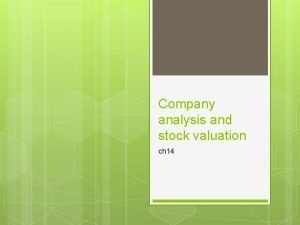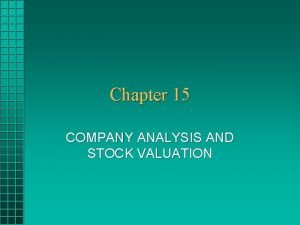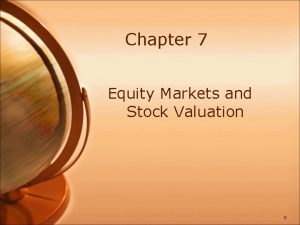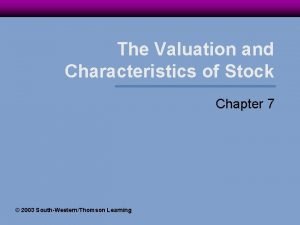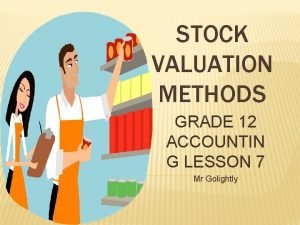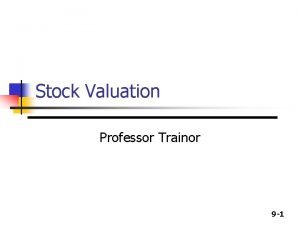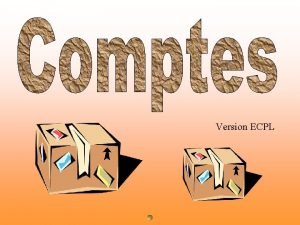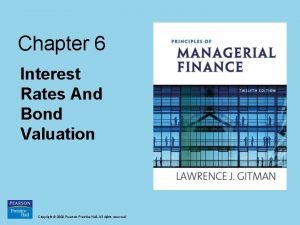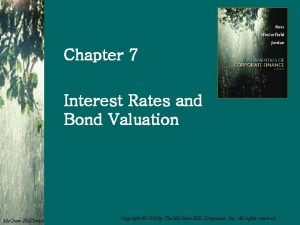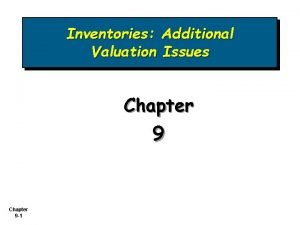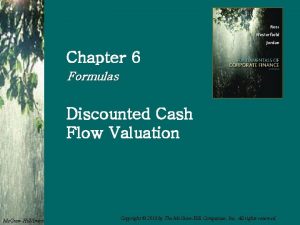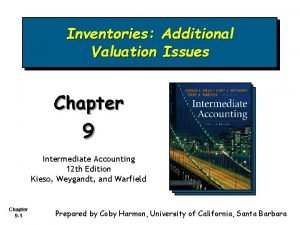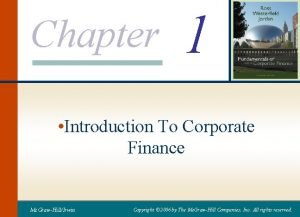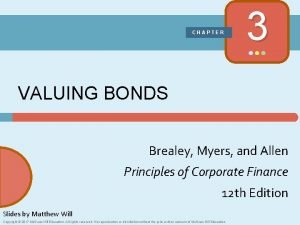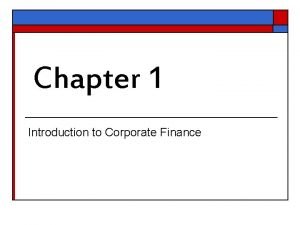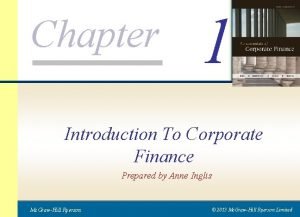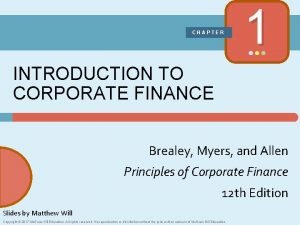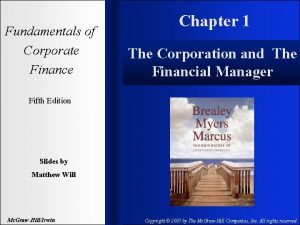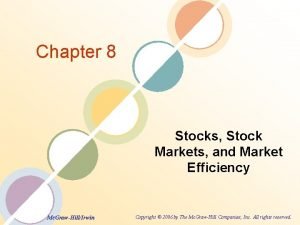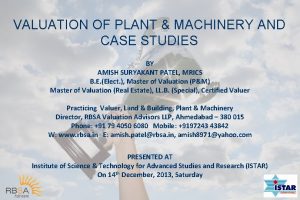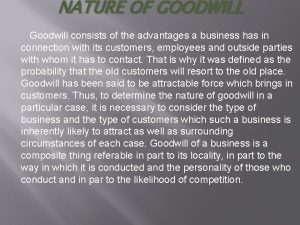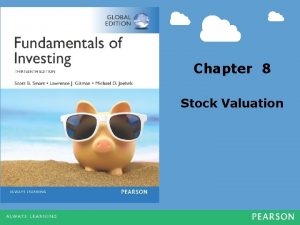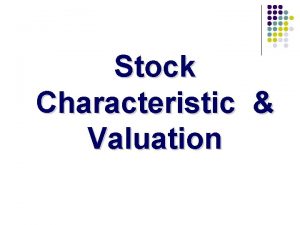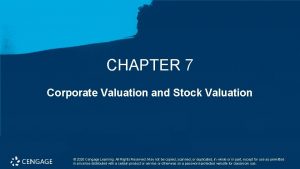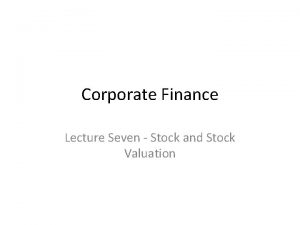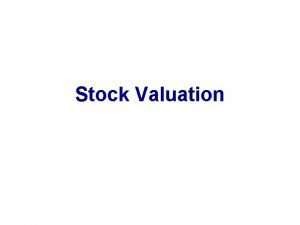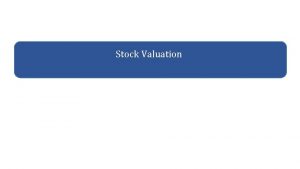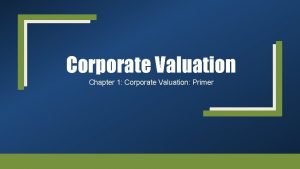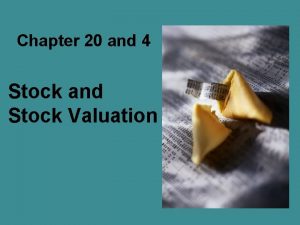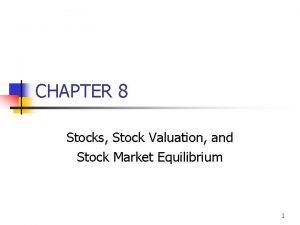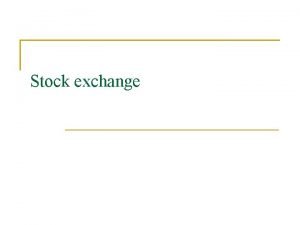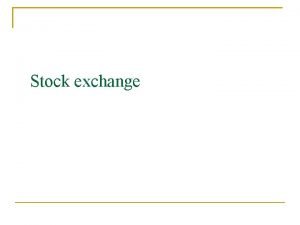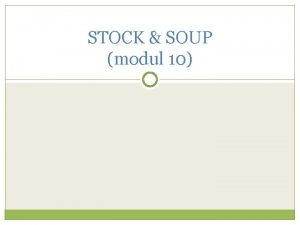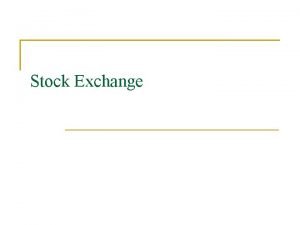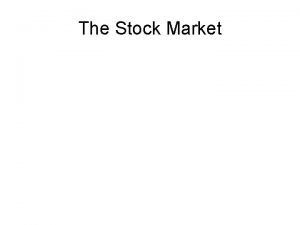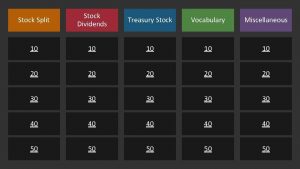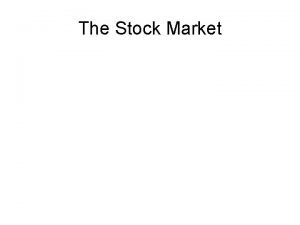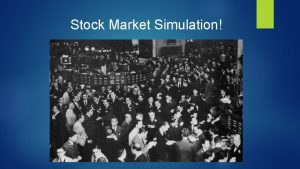CHAPTER 7 Corporate Valuation and Stock Valuation 1



































- Slides: 35

CHAPTER 7 (Corporate Valuation) and Stock Valuation 1

Topics in Chapter Read sections: 7 -1, 7 -2, 7 -3, 711(abc), 7 -8, 7 -10, 7 -12, 7 -14. n n Features of common stock Valuing common stock n n n Dividend growth model Market multiples Preferred stock 2

Corporate Valuation and Stock Valuation Firm’s debt/equity mix Free cash flow (FCF) Weighted average cost of capital (WACC) Dividends (D) Cost of equity: The required return on stock Cost of debt

Overview n n There are two widely used DCF valuation models: the free cash flow valuation model for corporate valuation (then through further calculations to indirectly get stock value) and the dividend growth model (directly) for stock valuation. In this chapter we will focus on the dividend growth model, and defer the FCF method to Chapter 11. (Please see the previous slide for illustration and the box on P 294 for discussion. ) 4

7 -1 Legal Rights and Privileges of Common Stockholders n n n n Represents ownership. Ownership implies control. Stockholders elect directors: vote in person or through proxy at annual meetings. The board hires management. Since managers are “agents” of shareholders, their goal should be: Maximize stock price. But agency problem may exist. Other: Preemptive Right (7 -1 b) and Dividend Right. 5

7 -2 Types of Common Stock n n Most firms have only one type of common stock. Classified stock has special provisions to meet special needs. Could classify existing stock as founders’ shares (Class B), with voting rights but dividend restrictions. New shares might be called “Class A” shares, with voting restrictions but full dividend rights. 6

7 -3 Stock Market Reporting n n With the advancement in information technology, today you can get real time quotes from many different Internet sources: www. finance. yahoo. com www. google. com/finance etc. 7

Different Approaches for Valuing Common Stock: Overview n Dividend growth model n n Constant growth stocks Nonconstant growth stocks (skipped) Free cash flow model (skipped) Using the multiples of comparable firms 8

7 -11 Valuing Common Stocks with the Dividend Growth Model 7 -11 a Definitions of Terms Used in Stock Valuation Models (for this textbook) 7 -11 b Expected Dividends as the Basis for Stock Value ^ P 0 = D 1 (1 + rs)1 + D 2 (1 + rs)2 + D 3 +…+ (1 + rs)3 D∞ (1 + rs)∞ Stock value = PV of all future dividends discounted at required return Conceptually correct, but how do you find the present value of an infinite stream? 9

7 -11 c Valuing a Constant Growth Stock: the Gordon Model Assumption: Suppose dividends are expected to grow at a constant rate, g, forever. Dividend Assumption: D 1 = D 0(1 + g)1 D 2 = D 0(1 + g)2 … Dt = D 0(1 + g)t What is the present value of a constant growth Dt when discounted at the stock’s required return, rs? See next slide. 10

Present Value of a Constant Growth Dividend Dt n PV(Dt) = n What happens to n n If g<rs: Then as t gets large. as t gets bigger? < 1 and approaches zero So PV(Dt) approaches zero as t gets large. 11

Constant Dividend Growth: PV of Dt if g<rs $ Dt = D 0(1 + g)t D 2 D 1 D 0(1 + g)t PV of Dt = (1 + rs)t PV PV 1 of of D 1 2 D 2 g < r, PV(D∞) → 0 Years (t) 12

Constant Dividend Growth: Cumulative Sum of PV of Dt if g<rs What happens to t 1 (1/2)t 1/2 Σ(1/2)t 1/2 as t gets bigger? Consider this: 2 1/4 3 1/8 7/8 This sum converges to 1. Similarly, finite number. See next slide. 4 1/16 15/16 5 1/32 Boring converges to a 13

Constant Dividend Growth Model (g<rs) n If g is constant and less than rs, then converges to: 14

What happens if g > rs? ^ P 0 = D 0(1 + g)1 D 0(1 + g)2 (1 + rs)1 If g > rs, then ^ + (1 + rs)2 (1 + g)t +…+ D 0(1 + g)∞ (1 + rs)∞ >1 (1 + rs)t And P 0 = ∞ as t goes to infinity. So g must be less than rs for the constant growth model to be applicable! 15

7 -11 c (continued) Illustration of a Constant Growth Stock First step: estimate required rate of return Example: if beta = 1. 28, r. RF = 7%, and RPM = 5%. Use the CAPM/SML to calculate rs: rs = r. RF + (RPM)b. Firm = 7% + (5%)(1. 28) = 13. 4% 16

Second step: Calculate Intrinsic Stock Value Using Gordon Model with dividend information Example Continued: D 0 = $1. 15, g = 8% D 1 = D 0(1+g) D 1 = $1. 15(1. 08) = $1. 242 17

7 -11 c (continued) Expected Rate of Return on a Constant Growth Stock: Rearrange the Gordon Model to rate of return form Example: if P 0=$23, D 1=$1. 242, and g=8%. What is the expected rate of return? D 1 ^ P 0 = to rs – g Then, ^ rs D 1 ^ rs = +g P 0 = $1. 242/$23. 00 + 0. 08 = 0. 054 + 0. 08 = 13. 4% 18

Expected Stock Price in 1 Year In general, for constant growth stock, In our example, D 2 = D 0(1+g)2 = 1. 15(1+0. 08)2 = $1. 3414 So = 1. 3414/(0. 134 -0. 08) = 1. 3414/0. 054 = $24. 84 19

Expected Dividend Yield and Capital Gains Yield for Year 1 D 1 $1. 242 Dividend yield = = = 5. 4% P 0 $23. 00 ^ P 1 – P 0 $24. 84 – $23. 00 CG Yield = = P 0 $23. 00 = 8% 20

Total Year 1 Return n Total return = Dividend yield + Capital gains yield. Total return = 5. 4% + 8% = 13. 4% Total return = 13. 4% = rs n For constant growth stock: capital gains yield = dividend growth rate g 21

7 -8 Do Stock Prices Reflect Longterm or Short-term Cash Flows? The current stock price is $23. 00. The PV of the first 5 dividends is: 1. 095+1. 043+0. 993+0. 946+0. 091 = 4. 98 (see calculation on next slide) The percentage of stock price due to “long-term” dividends is: $23 -$4. 98 = 78%. $23. 00 22

Suppose the stock price is $23. 00. Is this price based on short-term or long-term cash flows? Year (t) 0 Dt = D 0 (1+g)t PV(Dt) = Dt/(1+rs)t Sum of PV(Divs. 1 -5) $4. 98 P 0 $23 1 2 3 4 5 1. 242 1. 3414 1. 4487 1. 5646 1. 6897 1. 0952 1. 0431 0. 9934 0. 9461 0. 9010 % of P 0 due to the first 22% 5 PV(Divs. ) % of P 0 due to long-term divs. 78% 23

Intrinsic Stock Value vs. Quarterly Earnings n If most of a stock’s value is due to long -term cash flows, why do so many managers focus on quarterly earnings? n n Changes in quarterly earnings can signal changes in future cash flows. This would affect the current stock price. Managers often have bonuses tied to quarterly earnings, so they have incentive to manage earnings (agency problem). 24

7 -10 Why Are Stock Prices So Volatile? ^ P 0 = n rs – g rs could change: rs = r. RF + (RPM)bi n n D 1 Interest rates (r. RF) could change Risk aversion (RPM) could change Company’s risk (bi) could change g could change. 25

Estimated Stock Price: Changes in rs and g Growth Rate: g 11. 4% 7% $27. 97 8% $36. 53 9% $52. 23 n Required Return: rs 12. 4% 13. 4% 14. 4% 15. 4% $22. 79 $19. 23 $16. 63$14. 65 $28. 23 $23. 00 $19. 41$16. 78 $36. 87 $28. 49 $23. 21$19. 59 Small changes in g or rs cause large changes in the estimated price. 26

Are volatile stock prices consistent with rational pricing? n n n Small changes in expected g and rs cause large changes in stock prices. As new information arrives, investors continually update their estimates of g and rs. If stock prices aren’t volatile, then this means there isn’t a good flow of information. 27

7 -12 The Market Multiple Method (Focus: estimate the firm’s relative value) (Market Value Ratios in Chapter 3) (Focus: examine market consensus on the firm’s prospect ) n n n There are two basic approaches to Valuation: The DCF Approach to estimate the intrinsic value: the dividend growth model and the free cash flow valuation model etc. The Multiples Approach to evaluate the relative value: comparability is the key issue when applying this approach. 28

Using Stock Price Multiples to Estimate Stock Price n n Analysts often use the P/E multiple (the price per share divided by the earnings per share). Example: n n Estimate the average P/E ratio of comparable firms. This is the P/E multiple. Multiply this average P/E ratio by the expected earnings of the company to estimate its stock price. 29

Using Entity Multiples n The entity value (V) is the sum of: n n The value of equity (# shares of stock multiplied by the price per share) plus the value of debt. Pick a measure, such as EBITDA, Sales, (Customers, Eyeballs) etc. Calculate the average entity ratio for a sample of comparable firms. For example, n n V/EBITDA V/Customers 30

Using Entity Multiples (Continued) n Find the entity value of the firm in question. For example, n n n Multiply the firm’s EBITDA by the V/EBITDA multiple. Multiply the firm’s # of customers by the V/Customers multiple. The result is the firm’s total value. Subtract the firm’s debt to get the total value of its equity. Divide by the number of shares to calculate the price per share. 31

Problems with Market Multiple Methods n n It is often hard to find comparable firms. The average ratio for the sample of comparable firms often has a wide range. n For example, the average P/E ratio might be 20, but the range could be from 10 to 50. How do you know whether your firm should be compared to the low, average, or high performers? 32

7 -14 Preferred Stock n Hybrid security: n n Similar to bonds in that preferred stockholders receive a fixed dividend which must be paid before dividends can be paid on common stock. The preferred stockholders usually don’t have voting rights. However, unlike bonds, preferred stock dividends can be omitted without fear of pushing the firm into bankruptcy. 33

Value of Perpetual Preferred Stock: PV of Perpetuity Example: A perpetual preferred stock without stated maturity, Dividend = $8/year; Required return = rps = 8% Value of Preferred Stock with Stated Maturity: similar to Bond Valuation Example: a preferred stock has a maturity of 50 years, par value of $100, stated annual dividend rate of 8%. The similar risk preferred stocks are yielding 6% annually, what is the intrinsic value of this preferred stock? With Financial Calculator: N=50, I/Y=6, PMT=100*0. 08=$8, FV=100 CPT PV=-131. 52 34

Homework Problems n n Questions on P 333: 7 -1(aefgh), 7 -3; Problems on P 334: 7 -2, 7 -3, 7 -4, 7 -8, 7 -9, 7 -14. 35
 Company analysis stock valuation
Company analysis stock valuation Company analysis stock valuation
Company analysis stock valuation Equity markets and stock valuation
Equity markets and stock valuation Fixed income introduction
Fixed income introduction Objective of corporate finance
Objective of corporate finance Corporate valuation model
Corporate valuation model Long-term debt preferred stock and common stock
Long-term debt preferred stock and common stock Characteristics of corporate bonds and stocks
Characteristics of corporate bonds and stocks Avco stock valuation
Avco stock valuation Characteristics of stock valuation
Characteristics of stock valuation Inventory valuation methods pdf grade 12
Inventory valuation methods pdf grade 12 Dividend growth model formula
Dividend growth model formula Preferred stock valuation
Preferred stock valuation Fungsi soup
Fungsi soup Stock initial
Stock initial Chapter 7 interest rates and bond valuation
Chapter 7 interest rates and bond valuation Chapter 5 bonds bond valuation and interest rates solutions
Chapter 5 bonds bond valuation and interest rates solutions Chapter 6 interest rates and bond valuation
Chapter 6 interest rates and bond valuation Chapter 7 interest rates and bond valuation
Chapter 7 interest rates and bond valuation Chapter 6 interest rates and bond valuation
Chapter 6 interest rates and bond valuation Chapter 5 corporate liquidation and reorganization
Chapter 5 corporate liquidation and reorganization Chapter 9 inventories additional valuation issues
Chapter 9 inventories additional valuation issues Chapter 6 discounted cash flow valuation
Chapter 6 discounted cash flow valuation Lower of cost or market
Lower of cost or market Fundamentals of corporate finance chapter 6 solutions
Fundamentals of corporate finance chapter 6 solutions Introduction to corporate finance
Introduction to corporate finance Fundamentals of corporate finance chapter 1
Fundamentals of corporate finance chapter 1 Principles of corporate finance chapter 3 solutions
Principles of corporate finance chapter 3 solutions Examples of agency problems
Examples of agency problems Corporate finance chapter 1
Corporate finance chapter 1 Chapter 1 introduction to corporate finance
Chapter 1 introduction to corporate finance Chapter 1 introduction to corporate finance
Chapter 1 introduction to corporate finance Fundamentals of corporate finance, chapter 1
Fundamentals of corporate finance, chapter 1 Chapter 8 the stock market
Chapter 8 the stock market Plant and machinery valuation report sample
Plant and machinery valuation report sample Advantages of return on capital employed
Advantages of return on capital employed
